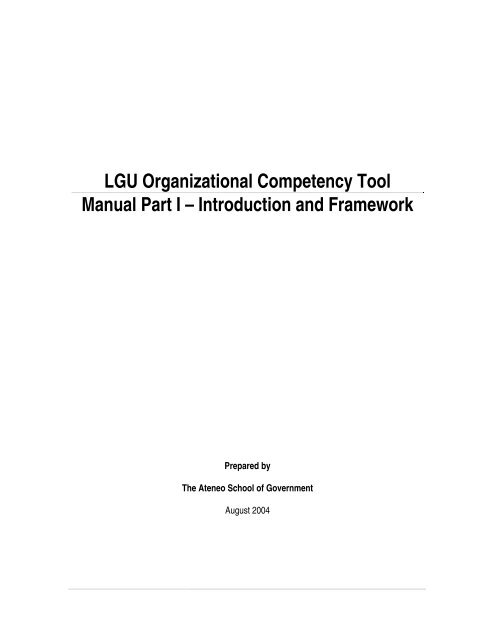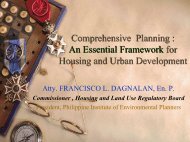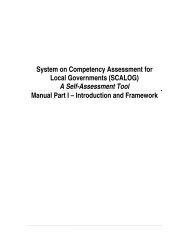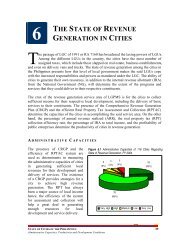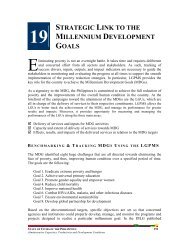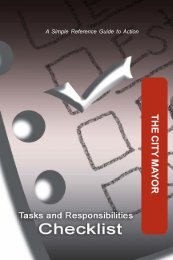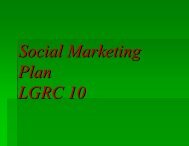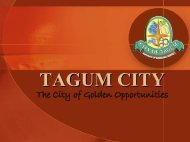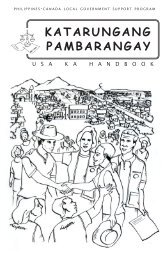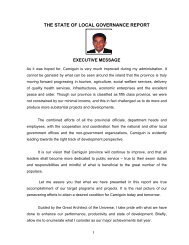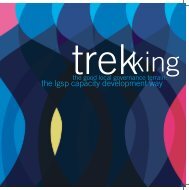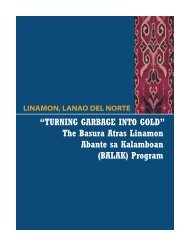Manual Part I-Intro and Framework7-30.pdf - LGRC DILG 10
Manual Part I-Intro and Framework7-30.pdf - LGRC DILG 10
Manual Part I-Intro and Framework7-30.pdf - LGRC DILG 10
- No tags were found...
You also want an ePaper? Increase the reach of your titles
YUMPU automatically turns print PDFs into web optimized ePapers that Google loves.
LGU Organizational Competency Assessment Tool<strong>Intro</strong>ductionPurposeThe purpose of the LGU Organizational Competency Assessment Tool is to promote continuousimprovement in local government units through the identification of organizational strengths <strong>and</strong>areas for development that can be addressed through capacity building efforts.What are “Organizational Competencies”?Organizational competencies are an integrated set of work processes, structures, systems <strong>and</strong>technologies that a LGU must have to render <strong>and</strong> sustain superior performance. They may alsobe referred to as “institutional or organizational capacity”.Organizational competencies are different from individual competencies. A helpful distinction isshown below:Individual Competency = knowledge + skills + attitude + experienceOrganizational Competency = competent workforce + valid structures + efficientprocesses + effective leadership <strong>and</strong>management style + adequate resources +appropriate technology, tools, facilities +appropriate culture + effectivepolitical/participatory processes.As indicated above, individual competencies are one component of organizational competency<strong>and</strong> manifested in a competent workforce. Other components provide the context that enablegood performance within the organization.Why are Organizational Competencies important?The practice of capacity building for LGUs in the country reveals that individuals are often thefocus of analysis <strong>and</strong> training is often seen as the answer to performance gaps or organizationalchange. We also know from our own experience <strong>and</strong> research findings that training is neitherenough nor always an appropriate response. The problem may not simply be the lack ofcompetent warm bodies but the absence of an organizational environment supportive of goalfocused<strong>and</strong> results-oriented performance. The latter is the main focus of organizationalcompetencies. Organizations <strong>and</strong> individuals do not perform in a vacuum; their ability to carry outtheir assigned responsibilities is deeply affected by the broader context within which they operate,i.e. the structures, processes, systems <strong>and</strong> culture that govern their behavior. Therefore,assessing the organizational competencies of LGUs provides for a broader, more wholisticst<strong>and</strong>point in determining capacity improvement needs.How does the Organizational Competency Assessment Tool relate to the LGPMSframework?The LGPMS measures the inputs <strong>and</strong> outputs/outcomes of LGU performance. The OrganizationCompetency Assessment Tool measures the “throughput” or the capacity of the LGU to transforminputs into outputs <strong>and</strong> outcomes.1
• The LGU has a strategic plan for the service.• There is a clear process for initiating projects.• There is a st<strong>and</strong>ard planning process for these projects.• There is a st<strong>and</strong>ard process for monitoring the implementation of these projects.• There is a st<strong>and</strong>ard process for assessing completed projects.• There is complementation/ synergy with other local government programs/ services.Complementation/ synergy means projects coordinate/build on each other so thatduplication of efforts or conflicting initiatives are avoided.• The LGU has mutual cooperation agreements or other forms of linkages with otherLGUs, NGOs, educational/research institutions, etc., to implement programs in thisservice area.5. <strong>Part</strong>icipationInvolving various stakeholders in problem identification, needs assessment, <strong>and</strong> informulation <strong>and</strong> implementing goals. Stakeholders are individuals or groups who cancontribute to or benefit from the service. The indicators of this competency may include:• NGOs/ people’s organizations are represented <strong>and</strong> are active members of councils,committees or boards.• There are other forms of LGU-NGO/ private sector tie-up• There is an accreditation process for NGOs, Pos, cooperatives, other developmentassociations.• The LGU uses different forums for stakeholders to raise <strong>and</strong> analyze issues, such as:public hearings, community/ town hall meetings, barangay assemblies, focus-groups<strong>and</strong> other forms of citizen engagement.• The participation of stakeholders has resulted in changes in the plans/ programs.6. Continuous Improvement/ Innovations<strong>Intro</strong>ducing new or modifying existing work processes/ procedures/ approaches toaccomplish most with the least overall expenditure of time <strong>and</strong> resources. The indicators ofthis competency may include:• The LGU has introduced improvements or innovations in this service area.• The LGU has applied Information <strong>and</strong> Communication Technology to this service area.7. Customer ServiceStreamlining frontline services to make them more customer-friendly <strong>and</strong> seeking feedbackfrom customers regarding services.• The LGU reviews/evaluates its frontline services to identify areas for improvement.• The LGU streamlines its frontline services in terms of reduction in:• processing/transaction time• number of requirements• number of signatories• number of steps• The LGU provides customer service training or orientation to its frontline staff.About the LGU Organizational Competency Assessment ToolThe LGU Organizational Competency Assessment Tool is divided into 14 service areainstruments. Each instrument has three parts:• <strong>Part</strong> 1: Organizational Competency Assessment Items – This part consists of 14 sectionsrepresenting the service areas of the Local Government Performance ManagementSystem.• <strong>Part</strong> 2: LGU Strengths <strong>and</strong> Opportunities for improvement3
Appendix BCompetency: Management SystemsCompetency Scores by Service AreaCompetencyAverageRating1 2 3 4 5Financial Accountability 5Local Legislation 3Development Planning 3Revenue Generation 4Resource Allocation <strong>and</strong>UtilizationHuman ResourceDevelopment <strong>and</strong>Management33Health <strong>and</strong> Nutrition 2Education 4Housing <strong>and</strong> Basic Utilities 2Peace, Security <strong>and</strong> DisasterPreparednessAgriculture <strong>and</strong> FisheriesDevelopmentEnterprise, Business <strong>and</strong>Industrial PromotionNatural ResourcesManagementWaste Management <strong>and</strong>Pollution Control234338
Service Areas Strong in Management SystemsFinancial Accountability• …• …Enterprise, Business <strong>and</strong> Industrial Promotion• …• …Service Areas Needing Improvement in Management SystemsHealth <strong>and</strong> Nutrition• …• …Housing <strong>and</strong> Basic Utilities• …• …Peace, Security <strong>and</strong> Disaster Preparedness• …• …Etc. …9


